REDISCOVERING
AMERICA’S CINDERELLA MAN: How The Story Of Braddock Found Its
Way Into The Hearts Of Filmmakers…and Two Actors
Jim Braddock rose from obscurity to become a household hero in the
1930s, but by the end of the century, his story of remarkable courage
and devotion had nearly been lost. Yet for those working in the world
of sports and sports journalism, particularly boxing, the legend he
created continued to win fans and devotees among many who happened
upon the archival press coverage of the fighter and his rise-to-fame
matches.
Longtime
sports and boxing fan Cliff Hollingsworth was one of those touched
by Braddock’s story and felt the man’s driving battle
to provide for his family (and unanticipated fame that resulted from
his upset matches) was a great tale deserving of a big screen adaptation.
Beyond the simple sports victory lay a larger tale of personal triumphs
that become the stuff of dreams.
“The journey began in 1994 when I happened to think about Jim
Braddock and his incredible rags-to-riches story and I thought what
a great movie that would make,” remembers Hollingsworth. “I
was already familiar with the story. As a longtime boxing fan, I’d
read about all of the former heavyweight champions and Jim Braddock
has always been my favorite.”
Through a fortuitous turn of events, Hollingsworth was able to contact
one of Braddock’s nephews, who put him in touch with Braddock’s
two sons, Jay and Howard; they then agreed to cooperate with the writer.
In subsequent meetings, the Braddock sons shared stories of their
famous father and later, an initial draft of the script met with the
family’s approval.
“The Jim Braddock story is unusual in more ways than one,”
observes Hollingsworth. “He inspired the nation in 1935 and
was a national hero, yet he became a largely forgotten figure. Jay
told me of how he would mention that his father was once the heavyweight
champion of the world and usually the person would never have heard
of Jim Braddock—that was very frustrating for him. It’s
my hope that this forgotten hero will be remembered once again.”
Another longtime boxing fan who became committed to telling Braddock’s
story once he heard the gripping details of the boxer’s transformation
into the Cinderella Man was actor Russell Crowe. Crowe was so deeply
moved by Braddock’s journey—from a man on the street trying
to keep his beloved family from the clutches of poverty to an invincible
sports champion and hero of the common person—that he devoted
himself to bringing it to the screen.
Crowe saw Braddock as unique among movie heroes in that he wasn’t
fighting for a cause or for fame or even for personal victory so much
as he was just doing everything in his power to take care of those
he loved. It was this “ordinariness” that had made Braddock
such a Cinderella Man – crowd-pleasing hero in the 1930s and
Crowe felt today’s audiences would be equally riveted by what
the athlete had achieved in the name of simply being a husband and
a father.
“For me, Cinderella Man is the story of how one family survived
the Depression,” says Crowe, whose earlier portrait of a Roman
general turned arena fighter in Ridley Scott’s Gladiator won
the Academy Award® for Best Actor. “Braddock went on with
his life after boxing, bringing up his family, working for a living,
loving his wife and watching his children grow and his grandchildren
born and in 1974, dying in the house he bought with the winnings from
that fight way back in 1935. I took his legacy to heart. I wanted
people to hear this true American story.”
Crowe continued to be fascinated by Braddock over the next few years.
Then came A Beautiful Mind, in which Crowe starred as the genius Nobel
Prize winner John Forbes Nash, Jr., in a story about both the fragility
and the triumphs of the human spirit. That film, which went on to
win the Oscars® for Best Picture and Best Director, among others,
was directed by Ron Howard and produced by Brian Grazer and Howard.
After Crowe and Howard got to know each other better while working
on A Beautiful Mind, Crowe gave Ron a copy of the script…and
the director, who had long been interested in a film set during the
Great Depression, also felt that the Jim Braddock story addressed
a lot of the themes that continue to resonate with him. Like Crowe,
Howard was intrigued not only by Braddock’s comeback-of-all-sports-comebacks,
but even more so by his place in the pantheon of folk heroes who seem
to reveal something vital about America’s national character.
With films that include A Beautiful Mind, Apollo 13, Backdraft, Parenthood,
The Paper, Cocoon, Far and Away and the recent The Missing—films
that traverse a broad array of subjects ranging from the mysteries
of genius to the courage of space travel, from family chaos to the
dark days of the Western frontier—Howard has come at the American
experience from any number of different angles. He regularly and deftly
jumps from genre to genre. But throughout his career he has always
been an American classicist, drawn to exploring the core elements
of the American temperament: individualism, heroism, family bonds,
devotion to ideals, strength of spirit and the powerful allure (and
sometimes heartbreaking realities) of the American Dream. All of these
seemed to be at work in Jim Braddock’s story.
“I am always most interested in taking audiences and placing
them directly into fresh situations, whether it’s going deep
inside the mind of a mathematician or face-to-face with araging fire
or becoming completely weightless in a space capsule,” explains
Howard. “This film gave me a chance not only to get into the
1930s boxing ring, but also to take audiences on a ride with a man
whose life quite suddenly changed from a nightmare of pure survival
into a fairy tale of the most inspiring proportions. Jim Braddock
went through an amazing transformation in front of the world. That
was something really interesting to me. Because as moving and inspiring
as Jim Braddock’s story is on the outside, it’s only when
you get on the inside—inside his love for his wife and the simple
desire to take care of his family that he shared with so many people—that
you see the real basis for his courage which makes his story so powerful
and enduringly relevant.”
The filmmaker also saw a grander theme illuminated in the simple quest
of Braddock— one that has figured heavily in his previous screen
stories. He continues, “There is something inherently tough
about Americans. They will not admit defeat. Failure is not an option.
The astronauts [of Apollo 13] would not give up. John Nash [of A Beautiful
Mind] would not give up. And Jim Braddock would not surrender to poverty.”
|
TURNING
INTO CINDERELLA MAN: How Russell Crowe Approached the Role of a Quiet
Man Who Became an Unwitting Hero
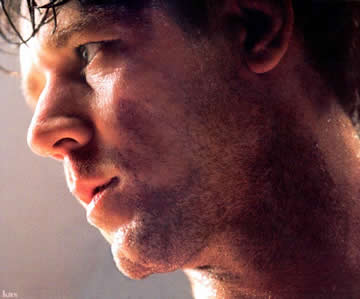
In addition
to the research and preparation for embodying the character of Braddock,
Crowe would need to undergo a great deal of physical training to portray
a man who possessed not only the courage but the physical prowess
and pugilistic skills to take on the greatest fighters of his time.
Crowe began the process by immersing himself in the archives of photographs
and film reels that still exist of Braddock in his fighting heyday.
He spent hours meticulously analyzing the fighter’s every movement
and facial expression in the ring, dissecting his character’s
uncanny drive and persistence from the outside in. At the same time,
Crowe also began to study the art of boxing—the sport known
as “the sweet science” for its multifaceted mix of grace,
grit and strategy—with trainer Angelo Dundee, who for 21 years
trained the greatest champion of them all, Muhammad Ali. The next
task was to whip Crowe into the highly conditioned shape of a hungry
pro boxer. But because Crowe was devoted to absolute authenticity,
he didn’t want to use today’s far more sophisticated training
methods; rather, he wanted to use the same bare-bones methods Jim
Braddock would have used. From research, Crowe learned that boxers
in the 1930s rarely trained with weights, giving them a less cut physique
than current boxers, so his program studiously avoided pumping iron.
Instead, the emphasis was put on cardio and endless days and nights
of sparring, sparring and more sparring in the ring—which eventually
transformed the actor from 228 pounds of Master and Commander’s
Captain Jack Aubrey to Braddock’s fighting weight of 178.
Taking advantage of the actor’s natural athleticism, Dundee
brought in trainer Wayne Gordon, himself a former Olympic boxer, to
design a regimen that included kayaking, swimming, running, biking,
hiking mountains, skipping rope and working a bag – all designed
to build a naturally strong (but not overly muscular) body built for
power and endurance. Crowe trained with typical intensity, dropping
numerous pounds to better emulate Braddock’s physique—the
physique some said was too light and too battered to ever even hope
for a regional win, let alone a heavyweight championship.
To better capture Braddock’s unique pugilistic style, Crowe
also worked on choreography with Angelo Dundee, who was lucky enough
to have witnessed Braddock fight in person on several occasions. The
trainer taught Russell to use the left hook that Braddock developed
to overcome the weakness of his right hand and even how to carry his
body as if he were several inches taller, as Braddock was.
As the details came together, Crowe’s complete transformation
took Dundee aback. “I think I would have to go so far as to
say Russell is Jim Braddock,” says the venerable trainer. “I’m
amazed the way Russell picked up his mannerisms, his smoothness, the
legs, the way he slides, that slip, slide, block, slide, jab—boom!
Like Jim, he has just about the greatest left hook I’ve ever
seen. He’s got the speed, the rhythm, the determination and
especially the will. Best of all, he has learned to think like a fighter.
One thing about Braddock is that he was a smart fighter, and Russell
uses his noodle just like Braddock did. I do think if he wasn’t
an actor, Russell could have been a great fighter.”
Despite having worked with Crowe before, Ron Howard was also surprised
by how Crowe used his physical changes to demonstrate Braddock’s
transformation as a man. “What Russell has done so well is to
let Braddock evolve during the course of the movie—as both a
fighter and as a person. Russell draws from what he discerns and then
reflects that back in a very detailed way. It’s the root of
his immense talent. He has great instincts about what makes his character
tick and how to express it. The fights needed to be a reflection of
Cinderella Man Braddock’s character and Russell was able to
do that. Once again as an artist he proved himself to be superb.”
Adds producer Brian Grazer: “I’ve simply never seen anyone
dedicate themselves to a part with more intensity than Russell Crowe.”
Boxing also tends to reveal human frailty, and like Jim Braddock,
Crowe was not immune from injury. Just one week before shooting was
to begin, Crowe dislocated his shoulder while sparring aggressively.
The shoulder would require surgery, necessitating a seven-week delay
in production.
Undeterred, Crowe used his recuperation time to devote himself to
further refining his footwork and ring craft. He was back in the gym
just a week out of the operating room, working to strengthen the injured
shoulder back to fighting level. Meanwhile, the production team also
used the period to design more complex ring choreography. Ultimately,
Crowe saw the delay as a blessing in disguise, providing him, the
filmmakers, everyone involved more time to ensure an authentic portrayal.
The accident even gave Crowe new insight into Braddock’s inner
world, as the boxer himself so often fought while mentally steeling
himself against considerable bodily agony. Still, Crowe’s injury
did make for high tension for the rest of the production. “We
were told that Russell could easily re-injure his shoulder, and it
wouldn’t even take much to do it,” recalls Ron Howard.
“So we had to constantly find a balance between striving for
the best possible take without increasing the chances that Russell
could get hurt. It meant that everyone, Russell included, had to bring
even more care to his scenes.”
More
to come... |
ABOUT
THE CAST
Russell Crowe (Jim Braddock), who was most recently seen as Lucky
Jack Aubrey in Peter Weir’s historical action/adventure, Master
and Commander: The Far Side of the World, has received three consecutive
Academy Award® Best Actor nominations for his performance in:
The Insider 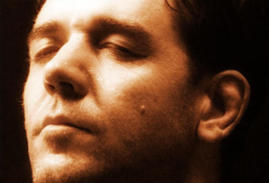 (2000),
Gladiator (2001) and A Beautiful Mind (2002). He won the Best Actor
Oscar® for his performance as Maximus, the Roman general-turned-gladiator,
in Ridley Scott’s blockbuster Gladiator. This role also earned
him Best Actor honors from several critics’ organizations, including
the Broadcast Film Critics. In addition, he received nominations from
the Hollywood Foreign Press Association, the Screen Actors Guild and
BAFTA. (2000),
Gladiator (2001) and A Beautiful Mind (2002). He won the Best Actor
Oscar® for his performance as Maximus, the Roman general-turned-gladiator,
in Ridley Scott’s blockbuster Gladiator. This role also earned
him Best Actor honors from several critics’ organizations, including
the Broadcast Film Critics. In addition, he received nominations from
the Hollywood Foreign Press Association, the Screen Actors Guild and
BAFTA.
In Ron Howard’s A Beautiful Mind, Crowe’s masterful portrayal
of Nobel Prizewinning John Forbes Nash, Jr. earned him his third Academy
Award® nomination and garnered him Best Actor awards from the
Golden Globes, Broadcast Film Critics Association, Screen Actors Guild
and BAFTA, among other critics groups. Crowe received his first Academy
Award® nomination for his work in Michael Mann’s non-fiction
drama The Insider, as tobacco company whistleblower, Dr. Jeffrey Wigand.
He also earned Best Actor Awards from the Los Angeles Film Critics,
Broadcast Film Critics, National Society of Film Critics and the National
Board of Review and nominations for a Golden Globe Award, a BAFTA
Award and a Screen Actors Guild Award.
Before his award-winning acclaim, Crowe made his mark in Curtis Hanson’s
crime drama, L.A. Confidential, as vice cop Bud White. He later starred
in Jay Roach’s Mystery, Alaska, and in Taylor Hackford’s
Proof of Life, opposite Meg Ryan. In 1995 he made his American film
debut in the Western The Quick and the Dead, with Gene Hackman and
Sharon Stone, and then starred as the cyber-villain Sid 6.7 in
Virtuosity, opposite Denzel Washington. Additional film credits include
Heaven’s Burning, Breaking Up, Rough Magic, The Sum of Us, For
the Moment, Love in Limbo, The Silver Brumby (based on the classic
Australian children’s novel), The Efficiency Expert and Prisoners
of the Sun.
Born in New Zealand, Crowe was raised in Australia where he has also
been honored for his work on the screen. He was recognized for three
consecutive years by the Australian Film Institute (AFI), beginning
in 1991, when he was nominated for Best Actor for The Crossing. The
following year, he won the Best Supporting Actor Award for Proof and,
in 1992, he received Best Actor Awards from the AFI and the Australian
Film Critics for his performance in the controversial Romper Stomper.
In 1993, the Seattle Film Festival named Crowe Best Actor for his
work in both Romper Stomper and Hammers Over the Anvil.
Crowe currently resides in Australia.
***************************************************
Even
as Russell Crowe was pursuing the part of Jim Braddock in the late
1990s, Renée Zellweger had become independently intrigued in
the story of Jim’s wife, Mae Braddock, whose enduring love and
belief famously spurred him on to one of the greatest sports upsets
in history. When Crowe found out about Zellweger’s interest,
he couldn’t have been happier. He had always wanted to work
with the actress whose recent roles have run the gamut from the criminal
harlot of the musical Chicago to her Oscar®-winning turn as the
hardscrabble farmer Ruby in Cold Mountain to the iconic modern single
woman, the title character of Bridget Jones’s Diary.
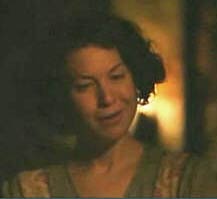 Zellweger
found herself drawn to Cinderella Man because she felt the story had
a classic American quality that has become all too rare in today’s
movie world. “It felt almost like a Frank Capra kind of American
movie tale,” she says, “and I’ve never done anything
like that before. It’s a very simple human story that is also
deeply moving and sometimes I think that we just don’t make
movies like that often enough any more.” Zellweger
found herself drawn to Cinderella Man because she felt the story had
a classic American quality that has become all too rare in today’s
movie world. “It felt almost like a Frank Capra kind of American
movie tale,” she says, “and I’ve never done anything
like that before. It’s a very simple human story that is also
deeply moving and sometimes I think that we just don’t make
movies like that often enough any more.”
She was also thrilled to join the team of Crowe, Howard and Grazer
and found that she fit right in. “I think what brought us all
together is that we all share a similar appreciation of good stories
and we all basically make movies for the same reasons,” she
explains. “It’s a personal thing for each of us and that
made this movie very meaningful.”
Zellweger sought to bring to Mae the inner fire and spunk that was
obviously so key in keeping the Braddock family together during the
impossibly hard times of the ‘30s. She says, “She’s
a spitfire, she loves her husband and is proud of his achievements,
she hates seeing him go off and fight, but she is unconditionally
supportive.”
Most of all, Zellweger sees Mae as central to one of the film’s
most poignant themes: the mixture of struggles and passion that bind
husbands and wives so closely. “My favorite thing about Cinderella
Man is that it always comes back to the connection between Jim and
Mae,” she says. “No matter what challenges they face,
they always make it through because of the strength of their relationship.
Their love is foundational in helping them through the harsh realities
of the times.”
To prepare for the role, Zellweger delved into as much research as
she could find about the real Braddock family—especially reading
through the more than 200 love letters that Jim Braddock wrote to
Mae. “It was such a rare opportunity to have this kind of material,”
she notes. “I felt very blessed to have it because it gave such
wonderful insight into the dynamic of their relationship. In reading
their letters, it was clear how beautiful their love for one another
was and how it carried them through the challenges they faced. A classically
moving, inspiring love story.”
She continues: “One thing I found especially moving is that
the Braddock kids weren’t ever fully aware of just how bad things
were. Jim and Mae managed to provide this incredible front that everything
was okay even though they were just barely surviving. It just reminds
you of how lucky we have become. It’s hard to imagine how difficult
it must have been to sacrifice everything so that your children wouldn’t
have to go to sleep at night worrying about food and having a roof
over their heads.”
From watching footage of Mae at press conferences, Zellweger also
discerned how painfully camera-shy Mae Braddock became after being
thrust into the spotlight through her husband’s sudden folk-hero
status. “She didn’t like the limelight at all,”
observes Zellweger.
“She was so uncomfortable, and in part I think it was because
she was so filled with fear that she might lose the man that she loved
to fighting.”
*****************************
With
a diverse roster of finely etched, critically acclaimed performances,
Paul Giamatti (Joe Gould) has established himself as one of the most
versatile actors of his generation.
Giamatti most recently starred in Alexander Payne’s critically-lauded
Sideways, a comedy about two men on a wayward wine-tasting trip in
California’s Santa Ynez Valley. Co-starring Thomas Haden Church,
Virginia Madsen and Sandra Oh, Sideways is the story of Miles (Giamatti),
a failed 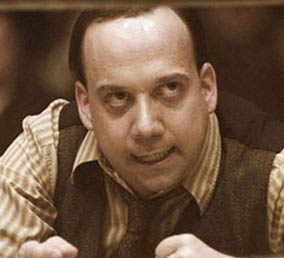 novelist,
and his soon-to-be married friend Jack (Church), a washed-up actor.
To salute the remains of their youth, the two men take one last road
trip in the week before Jack’s wedding. Giamatti earned several
accolades for his performance, including Best Actor from the Independent
Spirit Awards, New York Film Critics Circle and a Golden Globe nomination. novelist,
and his soon-to-be married friend Jack (Church), a washed-up actor.
To salute the remains of their youth, the two men take one last road
trip in the week before Jack’s wedding. Giamatti earned several
accolades for his performance, including Best Actor from the Independent
Spirit Awards, New York Film Critics Circle and a Golden Globe nomination.
Presently, Giamatti is slated to begin production on The Illusionist,
directed by Neil Burger. Giamatti stars opposite Edward Norton in
the story of a magician in turn-ofthe- century Vienna who falls in
love with a woman who is engaged to a prince. The magician uses his
powers to win her over and undermine the stability of the royal house
of Vienna.
Giamatti has also completed work on the independent feature The Hawk
is Dying, co-starring Michelle Williams and Michael Pitt. He plays
George Gatling, a Gainesville, Florida auto upholsterer attempting
to subvert his mundane life by training a wild, redtailed hawk.
Giamatti also lent his voice talents to the recent animated feature
Robots and the upcoming Ant Bully, slated for release in 2006.
Last year, Giamatti garnered outstanding reviews and commendations
(Independent Spirit Award nomination for Best Actor, National Board
of Review Breakthrough performance of the Year) for his portrayal
of Harvey Pekar in Shari Springer Berman and Robert Pulcini’s
American Splendor.
Giamatti first captured the eyes of America in Betty Thomas’
hit comedy Private Parts. His extensive list of film credits also
includes Milos Forman’s Man on the Moon; Tim Robbins’
The Cradle Will Rock; F. Gary Gray’s The Negotiator; Steven
Spielberg’s Saving Private Ryan; Peter Weir’s The Truman
Show; Mike Newell’s Donnie Brasco; Todd Solondz’s Storytelling;
Tim Burton’s Planet of the Apes; Duets, opposite Gwyneth Paltrow;
and Big Momma’s House, co-starring Martin Lawrence. Giamatti
also appeared in James Foley’s Confidence and John Woo’s
Paycheck.
As an accomplished stage actor, Giamatti received a Drama Desk nomination
for Best Supporting Actor as Jimmy Tomorrow in Kevin Spacey’s
Broadway revival of The Iceman Cometh. His other Broadway credits
include Chekov’s The Three Sisters, directed by Scott Elliot;
Racing Demon, directed by Richard Eyre; and Arcadia, directed by Trevor
Nunn. He was also seen off-Broadway in the ensemble cast of The Resistible
Rise of Arturo Ui with Al Pacino.
For television, Giamatti appeared in The Pentagon Papers with James
Spader; HBO’s Winchell, opposite Stanley Tucci; and Jane Anderson’s
If These Walls Could Talk
***********************************
Craig Bierko (Max Baer) is remembered for his successful Broadway
run starring in Meredith Wilson’s 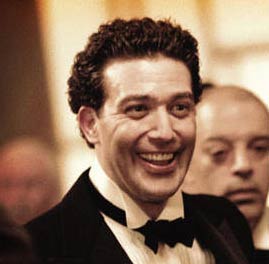 The
Music Man. Craig’s debut on Broadway as the legendary Harold
Hill garnered critical acclaim and attention; he was nominated for
the prestigious Tony Award, Drama Desk Award, Outer Critics Circle
Award, The Drama League Award and was the recipient of The Theater
World Award. Just prior, Bierko appeared in a staged workshop of The
Boys from Syracuse at The Roundabout Theatre. Born in Westchester,
New York, he made his stage debut at the age of 10 as a newsboy in
Gypsy, in a local community theater run by his parents. Bierko later
went on to study at Northwestern University. The
Music Man. Craig’s debut on Broadway as the legendary Harold
Hill garnered critical acclaim and attention; he was nominated for
the prestigious Tony Award, Drama Desk Award, Outer Critics Circle
Award, The Drama League Award and was the recipient of The Theater
World Award. Just prior, Bierko appeared in a staged workshop of The
Boys from Syracuse at The Roundabout Theatre. Born in Westchester,
New York, he made his stage debut at the age of 10 as a newsboy in
Gypsy, in a local community theater run by his parents. Bierko later
went on to study at Northwestern University.
Bierko
has enjoyed a diverse group of film roles, ranging from the villain
in Renny Harlin’s The Long Kiss Goodnight, opposite Geena Davis
and Samuel L. Jackson, to the comedic turn in Larry David’s
Sour Grapes and in the virtual reality thriller The Thirteenth Floor.
Additional film credits include Fear and Loathing in Las Vegas, The
Suburbans and Dickie Roberts: Former Child Star, written by Fred Wolf
and David Spade, directed by Sam Weisman
Television credits include memorable guest appearances on Sex and
the City, Ally McBeal and as Paul Reiser’s prospective agent
on Mad About You. Bierko most recently starred on Broadway in Daniel
Goldfarb’s comedy Modern Orthodox, also starring Molly Ringwald
and Jason Biggs.
*************************************
Since driving his motorcycle up the Delta House stairs as Daniel “D-Day”
Simpson in National Lampoon’s Animal House, Bruce McGill (Jimmy
Johnston) has been a constant and memorable screen presence. Throughout
his career he consistently receives rave reviews for his stand-out
performances, showing no sign of slowing down. Most recently, McGill
appeared in Michael Mann’s Collateral, alongside Tom Cruise,
Jamie Foxx and Mark Ruffalo, and will next be seen opposite Orlando
Bloom in Cameron Crowe’s Elizabethtown.
McGill has appeared in more than 60 motion pictures, including Runaway
Jury, Matchstick Men and Legally Blonde 2. His appearance as southern
attorney Ron Motley in Michael Mann’s The Insider garnered high
praise from critics and audiences alike.
Other film work includes The Sum of All Fears, Shallow Hal, The Legend
of Bagger Vance, Courage 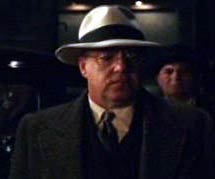 Under
Fire, My Cousin Vinny, The Last Boy Scout and Silkwood. McGill’s
list of television credits is equally impressive. He has starred in
some of HBO’s most critically acclaimed productions: portraying
controversial journalist Peter Arnet in Live From Baghdad; painting
a chilling portrait of Johnson-era cabinet member George Ball in Path
to War; and playing legendary Yankees manager Ralph Houk in 61*. Under
Fire, My Cousin Vinny, The Last Boy Scout and Silkwood. McGill’s
list of television credits is equally impressive. He has starred in
some of HBO’s most critically acclaimed productions: portraying
controversial journalist Peter Arnet in Live From Baghdad; painting
a chilling portrait of Johnson-era cabinet member George Ball in Path
to War; and playing legendary Yankees manager Ralph Houk in 61*.
He has made memorable guest appearances on CSI, The Practice, Gideon’s
Crossing, Home Improvement, Star Trek: Voyager, The Commish, Quantum
Leap, MacGyver and Miami Vice, among others. McGill also starred with
Glenn Close in The Ballad of Lucy Whipple on CBS and as family patriarch
George Osmond in ABC’s Inside the Osmonds.
Originally from San Antonio, Texas, McGill began his acting career
on stage in elementary school. After earning his BFA in acting from
the University of Texas at Austin, he made his professional debut
as a member of Rhode Island’s Trinity Square Repertory Company,
acting in productions of Tom Jones, Peer Gynt, Sherlock Holmes and
The Tooth of Crime. After relocating to New York City, he began a
long association with the New York Shakespeare Festival, appearing
in Hamlet (produced by the legendary Joseph Papp), Henry V and Othello,
playing Iago to Raul Julia’s Othello for the NYSF’s Shakespeare
in the Park series. Other theatrical affiliations include the Ensemble
Studio Theater in New York, the Kennedy Center for the Performing
Arts and National Shakespeare Company in Washington D.C. McGill currently
lives with his wife in Ojai, California, where he indulges in his
passion for golfing, sailing and music whenever possible.
*********************************
Paddy
Considine (Mike Wilson) has received much critical acclaim in the
last year for his roles in the successful British films Dead Man’s
Shoes and My Summer of Love.
Directed by Shane Meadows, and co-written by Meadows and Considine,
Paddy played the lead role as the tormented Richard in Dead Man’s
Shoes. It was for this performance that he was awarded Best British
Actor at the 2005 Evening Standard Film Awards and Empire Film Awards,
and nominated for Best British Actor at the London Film Critics Circle
and British independent Film  Awards.
The film also won Best British Film at this year’s South Bank
Awards and received a nomination for the Alexander Korda Award at
the 2005 BAFTA Film Awards. Awards.
The film also won Best British Film at this year’s South Bank
Awards and received a nomination for the Alexander Korda Award at
the 2005 BAFTA Film Awards.
Also released in Summer 2004, Paddy played the character of Phil (alongside
newcomers Nathalie Press and Emily Blunt) in My Summer of Love, directed
by Phil Pavlikovsky. The BAFTA Award-winning drama about the lives
of two young women who spend the summer together in the same village
earned Considine a nomination for Best Supporting Actor at the British
Independent Film Awards this year.
In 2002, Paddy played and the male lead of Johnny in In America, alongside
Samantha Morton and directed by Jim Sheridan. In addition, he played
Him in the BAFTA Award-winning short film My Wrongs 8245-8249 and
117. Other film credits include 24 Hour Party People, Last Resort
(for which he won Best Actor at the Thessaloniki Film Festival) and
A Room for Romeo Brass, also directed by Shane Meadows.
Later this year, following Cinderella Man, Paddy will be seen starring
as the character of Frank Thoroughgood in Stephen Woolley’s
directorial debut Stoned, about the events leading up to the death
of the ex-Rolling Stone Brian Jones.
|

 (2000),
Gladiator (2001) and A Beautiful Mind (2002). He won the Best Actor
Oscar® for his performance as Maximus, the Roman general-turned-gladiator,
in Ridley Scott’s blockbuster Gladiator. This role also earned
him Best Actor honors from several critics’ organizations, including
the Broadcast Film Critics. In addition, he received nominations from
the Hollywood Foreign Press Association, the Screen Actors Guild and
BAFTA.
(2000),
Gladiator (2001) and A Beautiful Mind (2002). He won the Best Actor
Oscar® for his performance as Maximus, the Roman general-turned-gladiator,
in Ridley Scott’s blockbuster Gladiator. This role also earned
him Best Actor honors from several critics’ organizations, including
the Broadcast Film Critics. In addition, he received nominations from
the Hollywood Foreign Press Association, the Screen Actors Guild and
BAFTA. Zellweger
found herself drawn to Cinderella Man because she felt the story had
a classic American quality that has become all too rare in today’s
movie world. “It felt almost like a Frank Capra kind of American
movie tale,” she says, “and I’ve never done anything
like that before. It’s a very simple human story that is also
deeply moving and sometimes I think that we just don’t make
movies like that often enough any more.”
Zellweger
found herself drawn to Cinderella Man because she felt the story had
a classic American quality that has become all too rare in today’s
movie world. “It felt almost like a Frank Capra kind of American
movie tale,” she says, “and I’ve never done anything
like that before. It’s a very simple human story that is also
deeply moving and sometimes I think that we just don’t make
movies like that often enough any more.” novelist,
and his soon-to-be married friend Jack (Church), a washed-up actor.
To salute the remains of their youth, the two men take one last road
trip in the week before Jack’s wedding. Giamatti earned several
accolades for his performance, including Best Actor from the Independent
Spirit Awards, New York Film Critics Circle and a Golden Globe nomination.
novelist,
and his soon-to-be married friend Jack (Church), a washed-up actor.
To salute the remains of their youth, the two men take one last road
trip in the week before Jack’s wedding. Giamatti earned several
accolades for his performance, including Best Actor from the Independent
Spirit Awards, New York Film Critics Circle and a Golden Globe nomination. The
Music Man. Craig’s debut on Broadway as the legendary Harold
Hill garnered critical acclaim and attention; he was nominated for
the prestigious Tony Award, Drama Desk Award, Outer Critics Circle
Award, The Drama League Award and was the recipient of The Theater
World Award. Just prior, Bierko appeared in a staged workshop of The
Boys from Syracuse at The Roundabout Theatre. Born in Westchester,
New York, he made his stage debut at the age of 10 as a newsboy in
Gypsy, in a local community theater run by his parents. Bierko later
went on to study at Northwestern University.
The
Music Man. Craig’s debut on Broadway as the legendary Harold
Hill garnered critical acclaim and attention; he was nominated for
the prestigious Tony Award, Drama Desk Award, Outer Critics Circle
Award, The Drama League Award and was the recipient of The Theater
World Award. Just prior, Bierko appeared in a staged workshop of The
Boys from Syracuse at The Roundabout Theatre. Born in Westchester,
New York, he made his stage debut at the age of 10 as a newsboy in
Gypsy, in a local community theater run by his parents. Bierko later
went on to study at Northwestern University. Under
Fire, My Cousin Vinny, The Last Boy Scout and Silkwood. McGill’s
list of television credits is equally impressive. He has starred in
some of HBO’s most critically acclaimed productions: portraying
controversial journalist Peter Arnet in Live From Baghdad; painting
a chilling portrait of Johnson-era cabinet member George Ball in Path
to War; and playing legendary Yankees manager Ralph Houk in 61*.
Under
Fire, My Cousin Vinny, The Last Boy Scout and Silkwood. McGill’s
list of television credits is equally impressive. He has starred in
some of HBO’s most critically acclaimed productions: portraying
controversial journalist Peter Arnet in Live From Baghdad; painting
a chilling portrait of Johnson-era cabinet member George Ball in Path
to War; and playing legendary Yankees manager Ralph Houk in 61*. Awards.
The film also won Best British Film at this year’s South Bank
Awards and received a nomination for the Alexander Korda Award at
the 2005 BAFTA Film Awards.
Awards.
The film also won Best British Film at this year’s South Bank
Awards and received a nomination for the Alexander Korda Award at
the 2005 BAFTA Film Awards.